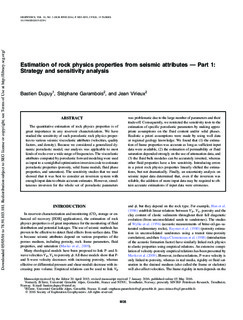| dc.description.abstract | The quantitative estimation of rock physics properties is of great importance in any reservoir characterization. We have studied the sensitivity of such poroelastic rock physics properties to various seismic viscoelastic attributes (velocities, quality factors, and density). Because we considered a generalized dynamic poroelastic model, our analysis was applicable to most kinds of rocks over a wide range of frequencies. The viscoelastic attributes computed by poroelastic forward modeling were used as input to a semiglobal optimization inversion code to estimate poroelastic properties (porosity, solid frame moduli, fluid phase properties, and saturation). The sensitivity studies that we used showed that it was best to consider an inversion system with enough input data to obtain accurate estimates. However, simultaneous inversion for the whole set of poroelastic parameters was problematic due to the large number of parameters and their trade-off. Consequently, we restricted the sensitivity tests to the estimation of specific poroelastic parameters by making appropriate assumptions on the fluid content and/or solid phases. Realistic a priori assumptions were made by using well data or regional geology knowledge. We found that (1) the estimation of frame properties was accurate as long as sufficient input data were available, (2) the estimation of permeability or fluid saturation depended strongly on the use of attenuation data, and (3) the fluid bulk modulus can be accurately inverted, whereas other fluid properties have a low sensitivity. Introducing errors in a priori rock physics properties linearly shifted the estimations, but not dramatically. Finally, an uncertainty analysis on seismic input data determined that, even if the inversion was reliable, the addition of more input data may be required to obtain accurate estimations if input data were erroneous. | nb_NO |
